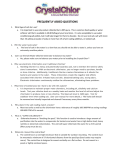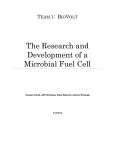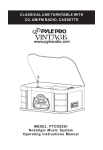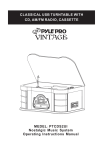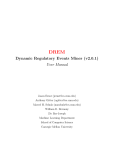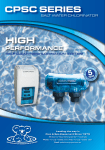Download MFC User Manual
Transcript
MFC-V1 – User Manual BioVolt MFC-V1 – User Manual BioVolt USER MANUAL MFC-V1 Congratulations on becoming an owner of the MFC-V1 by BioVolt. We at BioVolt have taken great care in making sure that this product performs to your expectations. The MFC-V1 has been designed by BioVolt to operate, with only limited maintenance, for over 1 year. It provides an environmentally friendly sustainable power source which can be used to fulfill a variety of small scale electrical needs. With the MFC-V1 you can charge the battery on a medical device, recharge your cell phone, or run LED lights to light up your house! MFC-V1 – User Manual Table of Contents 1 INTRODUCTION 2 INCLUDED WITH THE MFC-V1 2.1 BACTERIA 2.2 FEED MATERIALS 2.3 PARTS AND TOOLS 2.4 WARRANTY 3 ENVIRONMENT, HEALTH, AND SAFETY 3.1 ENVIRONMENT 3.2 HEALTH 3.3 SAFETY 4 PRODUCT OVERVIEW 4.1 HOW IT WORKS 4.2 CELL LAYOUT 5 CARING FOR THE BACTERIA 5.1 HEALTH CONSIDERATIONS 5.2 NUTRIENTS 6 GETTING STARTED 6.1 INITIAL SETUP 6.2 STARTING BACTERIAL GROWTH 7 GENERAL OPERATION 7.1 MEDIA RECIPE 7.2 BUFFER RECIPE 7.3 FEEDING THE BACTERIA 7.4 DISCARDING WASTE 8 MAINTENANCE 8.1 FILTER REPLACEMENT 8.2 BUFFER REPLACEMENT 9 TROUBLESHOOTING 10 GLOSSARY OF TERMS 2 BioVolt MFC-V1 – User Manual BioVolt 1 INTRODUCTION The MFC-V1 by BioVolt is a microbial fuel cell which has been designed to produce enough power to light low power LED lights and charge batteries for use in medical equipment, emergency cellular telephones, or other electronic devices. A microbial fuel cell (MFC) is a “battery” which produces power using a specific species of bacteria. This bacteria eats a specific food solution, called the bacterial media, and produces electrical power which the MFC-V1 harnesses. More information about your new MFC can be obtained by calling or emailing BioVolt at: 1-800-BIOVOLT [email protected] or find us online at biovolt.org *NOTE: ALL CONTACT INFORMATION IS FOR DEMONSTRATION PURPOSES FOR THIS DOCUMENT ONLY AND IS IN NO WAY AFFILIATED WITH BIOVOLT OR ANY OF ITS TEAM MEMBERS. 3 MFC-V1 – User Manual BioVolt 2 INCLUDED WITH THE MFC-V1 2.1 BACTERIA The species of bacteria included with the MFC-V1 is called Geobacter sulfurreducens. Proper care instructions are outlined in 5 CARING FOR THE BACTERIA. 2.2 FEED MATERIALS • • • • • • Sodium Phosphate Monobasic Sodium Phosphate Dibasic Ammonium Chloride Baking Soda (if requested) Non-Iodized Salt (if requested) White Vinegar (if requested) 2.3 PARTS AND TOOLS • • • 12 replacement filters (Part #009) 1/8 inch hex key (Part #018) Measuring spoons (if requested) 2.4 WARRANTY If at any time within the first year of ownership you experience any manufacturing default, you may send it back and BioVolt will fix or replace it at no charge to you. Also, if at any time the bacteria die of natural causes or your MFC-V1 ceases operation, BioVolt will replace it at no cost (user pays shipping and handling charges). Modifications to this product, or operation of this product in any way other than outlined in this manual, could void the manufacturer’s warranty. 4 MFC-V1 – User Manual BioVolt 3 ENVIRONMENT, HEALTH, AND SAFETY 3.1 ENVIRONMENT The operation of the MFC-V1 is environmentally friendly as it is utilizing natural processes to create your power. The bacteria waste is in two forms: the used liquid media and CO2 gas. A small amount of CO2 is produced as the bacteria consume the nutrients, and this gas waste is expelled from the anode chamber as you refill or pump in new media. The used media that exits the chamber is only a salt solution, and can be disposed of with no harm to the environment. 3.2 HEALTH Most of the ingredients in the media solution are kitchen appropriate and pose no harm if handled or ingested. If consumed in large quantities, patient may experience some discomfort. The sodium phosphate and ammonium chloride are less common items, but also pose no health threats due to exposure to the user. Ammonium chloride and phosphate are noted as mild skin irritants and the chloride is slightly acidic when dissolved in water, so should be handled with care. Should you experience any irritation or discomfort, wash area with soap and water. Seek medical attention if further irritation develops. The MSDS sheets for these compounds are included. 3.3 SAFETY Care should be taken when working with any device that carries an electrical charge. Proper care for connecting and disconnecting an electrical device to the MFC-V1 should be taken. 5 MFC-V1 – User Manual BioVolt 4 PRODUCT OVERVIEW 4.1 HOW IT WORKS The MFC gets its electricity by harnessing the metabolism of a certain type of bacteria, Geobacter sulfurreducens. This bacteria “eats” the food solution, called the media in biological terms, and gives off electrons as shown in Figure 1 below. By continuing to feed the bacteria the prescribed media, bacteria in the cell can grow and continue to produce electricity. The bacteria are fed by filling the media storage chamber with fresh media and injecting the new media into the anode chamber via the injection pump system. Any waste media is then discarded out of the waste stream. MFC-V1 – User Manual BioVolt 4.2 CELL LAYOUT #003 #002 #001 Figure 2. Full cell cutaway with part numbers #004 #005 #006 Figure 3. Cell end cap #007 #001 #010 #006 Figure 1. Schematic showing the biology and operation of the MFC-V1 #008 #004 #009 Figure 4. Injection apparatus close-up view 6 7 MFC-V1 – User Manual BioVolt MFC-V1 – User Manual BioVolt 4.3 PARTS LIST #015 #002 #012 #014 #013 #011 #008 Figure 5. Anode chamber close-up view #017 #013 # 001 Media Storage Chamber # 002 Anode Chamber #003 Cathode Chamber #004 Waste Outlet #005 Level Indicator #006 Injection Pump #007 Media Storage Chamber Fill Cap #008 Injection Hose #009 Bacterial Filter #010 Media Storage Chamber End Cap #011 Anode Terminal #012 Proton Exchange Membrane #013 Graphite Electrodes #014 Insulated Copper Wire #015 Anode Fill Plug #016 Cathode Terminal #017 Cathode Chamber Fill Cap #018 Drain Hex Key #012 #014 #003 #016 Figure 6. Cathode chamber close-up view 8 9 MFC-V1 – User Manual BioVolt 5 CARING FOR THE BACTERIA 5.1 HEALTH CONSIDERATIONS Several simple steps are necessary for Geobacter sulfurreducens, the bacteria used in the MFC-V1, to remain in peak health: • • • • • Always follow the media recipe accurately Ensure only clean water is used in the MFC Never leave the anode chamber open to air Avoid exposure of the bacteria to direct sunlight Follow all procedures outline in this manual 5.2 NUTRIENTS The media solution has been specifically designed for the optimal health of the bacteria as well as optimal power output. The feed for the bacteria is vinegar, the main component of which is called acetate. The bacteria digesting vinegar creates the power of the MFC-V1. Sodium phosphate acts as a phosphate source and ammonium chloride acts as a nitrogen source to promote bacterial growth and health. Baking soda makes the media less acidic so that the bacteria is able to survive in the media. Table salt provides the bacteria with a source of sodium which helps to promote bacterial health. 10 MFC-V1 – User Manual BioVolt 6 GETTING STARTED 6.1 INITIAL SETUP After receiving the cell follow the instructions for making media given in 7.1 MEDIA RECIPE. Make a 3x batch of media to initially fill the anode and media storage chamber. Fill the anode chamber (Part #002) half full with media by removing the anode fill plug (Part #015). Add provided bacteria to cell. Fill the rest of the chamber with media trying to leave as little air space as possible. Replace fill plug. Fill the media storage chamber with the remaining media. Inject media using the injection pump until some volume of waste is removed with each pump. Once the anode chamber is full, follow the instructions outlined in 7.2 BUFFER RECIPE. Make one batch of buffer and add it to the cathode cell (Part #003). Leave the cathode fill cap (Part #017) off unless transporting the cell. The MFC is now ready to begin the bacterial growth phase. 6.2 STARTING BACTERIAL GROWTH Initial bacterial growth takes 12 days. Promote bacterial growth by connecting the anode terminal (Part #011) to the cathode terminal (Part #016) using a wire. Allow the cell to stand for 7 days without feeding. After 7 days, inject 30 pumps of new media. Allow cell to stand for another 5 days without feeding. After 5 days, remove the wire connecting the terminals. The MFC is now fully operational. Attach the positive and negative terminals (Part #016 and Part #011) to the desired load and begin operation under the procedure outlined in 7 GENERAL OPERATION. 11 MFC-V1 – User Manual BioVolt 7 GENERAL OPERATION 7.1 MEDIA RECIPE For the media to serve as an acceptable food source for the bacteria it must be made following these instructions: 1. Heat 1 liter of water to a boil 2. Let water cool to room temperature 3. Add: 1/4 teaspoon Ammonium Chloride 1/8 teaspoon Sodium Phosphate Monobasic 1/2 teaspoon Baking Soda 1 teaspoon White Vinegar A pinch Non-Iodized Salt 4. Mix until all ingredients are dissolved 7.2 BUFFER RECIPE The cathode buffer is prepared as the following recipe: 1. Measure 2 liters of water 2. Add 3/8 teaspoons of Dibasic Sodium Phosphate 7.3 FEEDING THE BACTERIA Verify that the media in the media storage chamber (part #001) is not cloudy. Cloudy media indicates that it has been contaminated by other bacteria. If media is cloudy discard immediately. Make sure the level indicator (Part #005) on the side of the cell shows sufficient media in the media storage chamber. Pump the media from the media storage chamber into the anode chamber (Part #002) where the bacteria is growing using the injection pump (Part #006). The optimal injection rate is 5 pumps per day to maintain adequate food levels. The bacteria can survive up to one week without food before showing any adverse effects. If left unattended for a number of days, inject all food which had been missed, in addition to food for the current day (i.e. 10 pumps if 1 day missed, 25 pumps if 4 days missed). 12 MFC-V1 – User Manual BioVolt Verify that the cathode buffer is not cloudy. If it is, follow the recipe outlined in 7.2 BUFFER RECIPE. Remove the cathode fill cap (Part #017) and leave the cap off whenever possible. 7.4 DISCARDING WASTE Discard all waste from the cell away from all water sources, especially drinking water. Cell waste may be used for watering plants or crops. 8 MAINTENANCE 8.1 FILTER REPLACEMENT The bacterial filter (Part #009) keeps other species of bacteria out of the cell and must be replaced at the beginning of each month. This is done by removing the media storage chamber end cap of the cell (Part #010). Removal of the cap will expose three hoses as well as the filter mechanism. Pull the hose off both sides of the used filter. Insert the new filter into the hose and replace end cap. 8.2 BUFFER REPLACEMENT The buffer in the cathode chamber should be replaced monthly, or when it appears very cloudy. Drain the old buffer out of the cathode drain by unscrewing the drain at the bottom of the cathode chamber using the supplied hex key (Part #018). When the chamber is empty replace the cathode drain. Prepare new buffer following the recipe outlined in 7.4 BUFFER RECIPE. Fill the cathode chamber with buffer halfway up the neck of the fill cap to the fill line. 13 MFC-V1 – User Manual BioVolt MFC-V1 – User Manual BioVolt 9 TROUBLESHOOTING 11 GLOSSARY OF TERMS Problem: The injection pump is very difficult to press or injects no fluid. Solution: The bacterial filter may be blocked. Replace the filter. ammonium chloride – an ingredient in the media anode – the negative terminal or side of a battery or fuel cell bacterial media – the food solution for the bacteria baking soda – an ingredient in the media buffer – any solution which resists changes in pH cathode – the positive terminal or side of a battery or fuel cell cutaway – a view where some of the structure is removed to reveal previously unseen parts dibasic sodium phosphate – see sodium phosphate dissolved – no visible solids remain in a liquid hex key – a hexagonally shaped piece of metal bent at a right angle. Used for turning screws and bolts. LED – stands for light emitting diode. A highly efficient form of lighting. load – the device or object to be powered media – see bacterial media media storage chamber – chamber in the MFC-V1 for storing media before it is pumped into the anode MFC – see microbial fuel cell MFC-V1 – the microbial fuel cell you own microbial fuel cell – a type of fuel cell which uses the metabolism of bacteria to create electrical current non-iodized table salt – an ingredient in the media sodium phosphate – an ingredient in the buffer solution and media solution. table salt – see non-iodized table salt white vinegar – an ingredient in the media Problem: The injection pump injects only air. Solution: There may not be enough media in the media storage chamber. Check the level indicator and add media as necessary. Problem: The MFC does not produce any power. Solution: There may be a loose connection on one of the terminals. Tighten all connections and retry. Problem: The MFC still is not producing any power. Solution: Feed the bacteria 50 pumps of media using the injection pump. Problem: The media in the media storage chamber is very cloudy. Solution: It has other species of bacteria growing in it. Dump and refill. Problem: I ran out of some ingredients. Solution: Order all supplies from BioVolt online at biovolt.org or over the phone at 1-800-BioVolt. Problem: Any problems we were unable to answer here? Solution: Call BioVolt Monday-Friday 8:00AM – 5:00PM (GMT – 05:00) Eastern Time (US & Canada) and one of our trained technicians will assist you. 14 15








